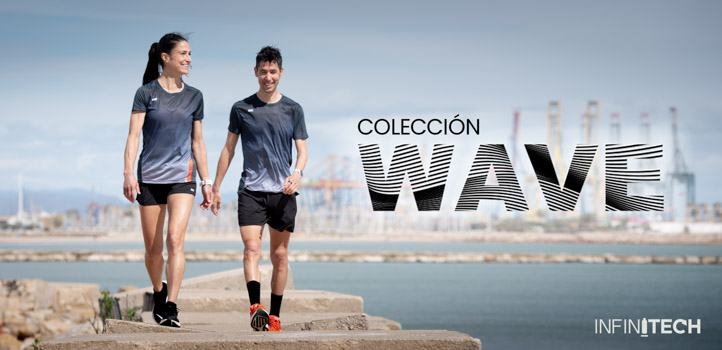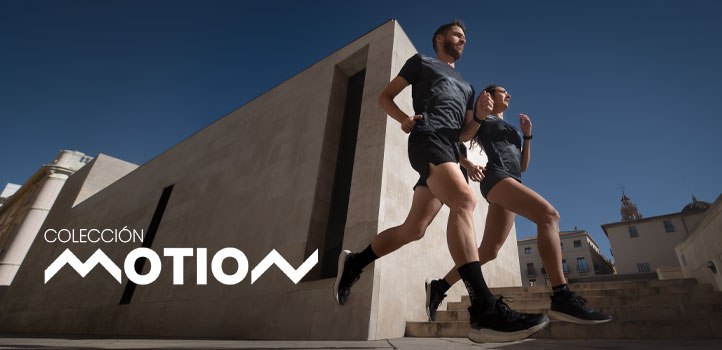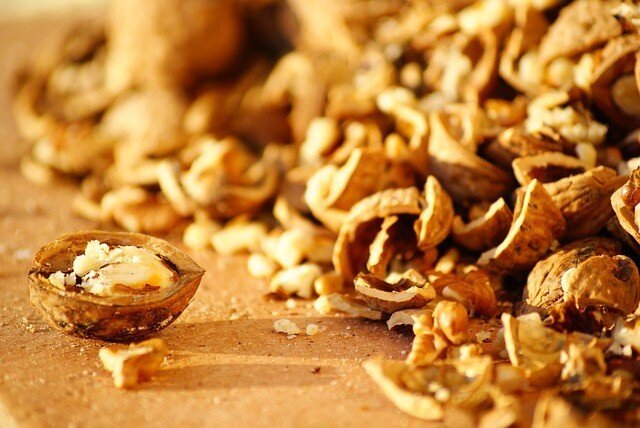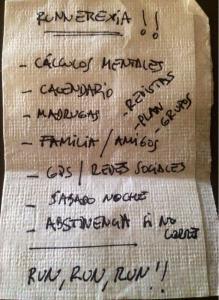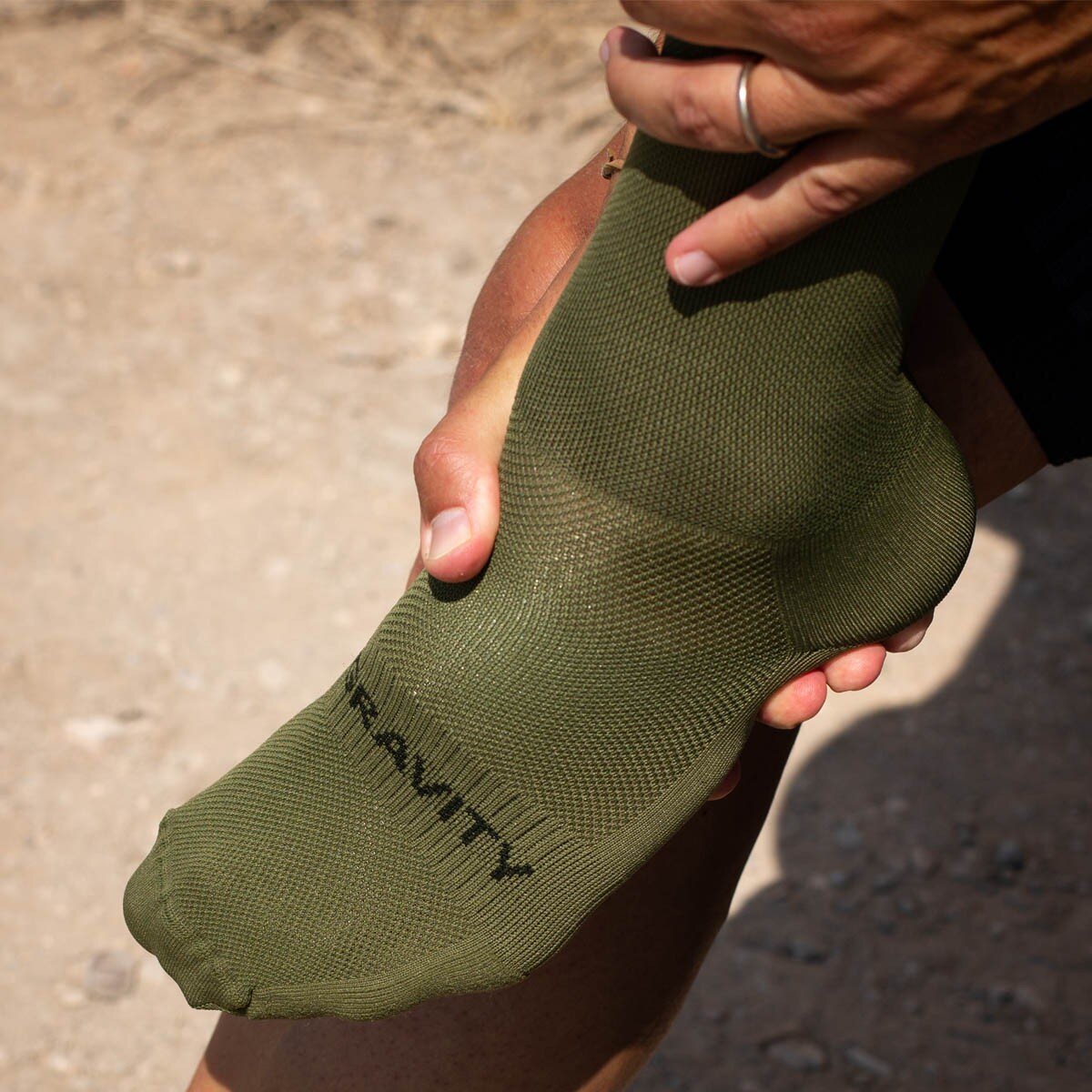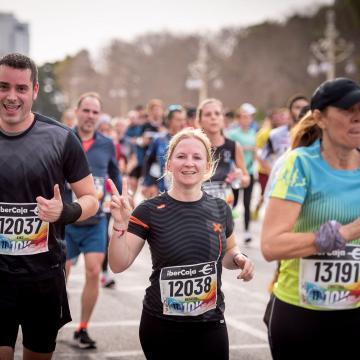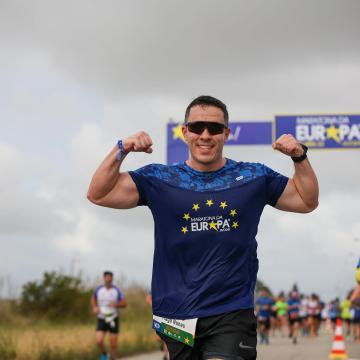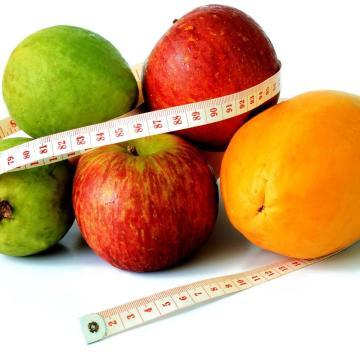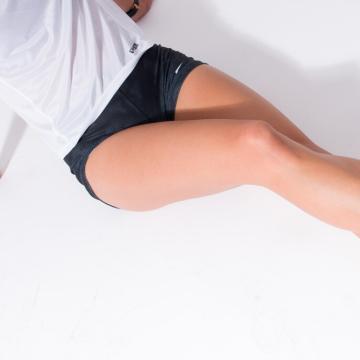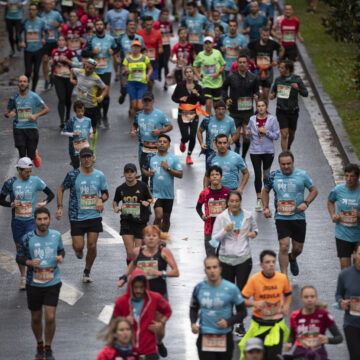Subscribe to our newsletter to find out about all the news and promotions, and automatically receive a welcome discount coupon in your email.
post -> What is the ideal fruit for the popular runner?
Sometimes the popular runners doubts assail them of what eat fruit before a workout. Not all fruits are valid for all types of workouts, our intake depends on the glycemic index of the fruit and the duration of the training.
En running.es They give us a series of recommendations that we want to share with you.
Regardless of the time we spend doing sports, it is always advisable to discard unripe fruit, as well as fruit that can cause a laxative effect, such as plums. Finally, it is advisable not to take the fruit in juice, since being concentrated provides too many carbohydrates at once and can cause stomach discomfort.
If we are going to make a long session (more than 2 hours) must avoid high-glycemic fruits (that is, those that contain sugars that are absorbed quickly), therefore we will leave aside the melon, watermelon, kiwi, even peach and apricots.
If the session is short (1 hour approximately) we will avoid those with a low glycemic index, since its effect at the level of energy contribution will appear when we are in the shower. These fruits are: strawberries, apple, cherries, grapefruit, orange and pear.
A great ally for diet from the corridor is oats because it stays with you throughout all physical activity, gradually releasing sugar into your circulatory system.
With regard to nuts, the ideal is a mixture composed of nuts or dried fruit. It has healthy sugar, which provides the quick energy you need, while seeds and nuts will maintain insulin levels when they tend to drop mid-workout. It should be remembered that seeds and nuts are high in fat, which takes much longer to digest. If you eat too much, you could start to feel super full and start to slow down as you go about your activity.
Yogurt can be added to them. It is easy for the stomach to digest and, combined with nuts or dehydrated fruit, it offers the energy reserves that the body needs.
If you are interested in popular runner nutrition articles visit our section Sport Nutrition
The cameras of Chrono TV accompany 42K to pick up testimonials from popular brokers.
This time we needed to know what was the worst moment you had spent as popular runners.
This is the video of the interviews, as you can see, there are very different testimonies, some surprising but they all have one thing in common; that moment when popular broker thinks:
Who tells me to get into this?
What if I stop or slow down?
What am I doing here with how good I would be having a few beers?
We hope you like them and that you feel identified.
That the running has become fashionable is a reality, as is the fact that most popular runners they run without a plan training, without doing any type of medical test, analysis, ...
All of this implies that in many cases, the popular runner improve a lot in the first months of its beginning but that there comes a time when it stagnates.
We have read several articles who talk about this and we have decided to make a summary in our blog, of those reflections of experts with which we totally agree.
El sports stagnation, it is simply a further consequence of the boom running of the last years in Spain. There are thousands of runners who start each year with a constant: they improve their physical form very quickly and then they stagnate.
According to different experts, the main causes of athletic stagnation are the following:
- Evolution and improvement too fast in the physical form of the runner.
- Lack of strength and muscle power.
- Overtraining.
- Excess of competitions
- Excess mileage
- Roll only.
- Training too hard
- Lack of physical rest
- Low ferritin levels
- Low levels of the red series in the blood or pseudo sports anemia.
- deficiencies in thelimentation
- Suffering from several injuries in a short time.
- Age
If the popular runners If they trained with prevention, with patience, regularly and without rushing to improve, they could evolve constantly for many years.
Getting the motivation to start a challenge is usually not difficult. Things go wrong afterwards. When the days, the weeks and the routine go by, it can jeopardize the objectives set.
This leads them to become unmotivated and to make big mistakes, doing the opposite of what they should. They train harder and harder instead of resting and lowering intensities. What happens to them? Have they really peaked and can't get any better? The answer is overwhelming: no. Everything is a matter of method and content in training. It usually has an easy solution. Lack of muscle strength and power is the most common cause of this type of stagnation.
If you want more information, we recommend that you read the following article from Runners.es
If many of us were asked what we like the most about running and what we least like, surely there would be common answers among us and others that are very different.
It's simple, each being is unique and unrepeatable but we are all runners at the same time, because we are all moved by the same passion.
That is the question that our friends from Lift television, for their CronoTV program, they have recently made some popular brokers and that we show you in this video.
Do you dare to tell us what you like the most and what you least like?
Source of the featured image of the post: Move Up Esportes
Interest in exercise, especially running, has seen a dramatic increase in recent years. As an example, in 1985 it was estimated that there were more than 35 million people who were long-distance runners in the United States. But... have any of them suffered from problems of iron deficiency?
In the Valencian Community, the first edition of the circuit Racancer for the Spanish Association Against Cancer, got 4.500 participants in its first call of 2016, in this year's edition (2018) 14.000 registered are expected.
The increase in physical activity, with undoubted positive values for health, is also generating biological disorders related to it.
Some runners are beginning to experience tiredness, irritability, loss of ability to concentrate, drowsiness, frequent yawning... In short, a state of loss of form for which they cannot find an explanation.
When these runners have had blood tests, the existence of iron deficiency has been shown, which could be at the origin of the symptoms described. In short, anemic pictures that explained the loss of fitness.
Iron deficiency
There are several mechanisms related to long-distance runners, by which an anemic state of iron deficiency can occur:
1. Hemolysis (rupture of red blood cells)
This fact was described for the first time during World War II, when observing dark urine (hematuria) in soldiers after carrying out large marches, which forced the investigation of new materials that cushion the impact of the feet on the ground, avoiding the rupture of red blood cells, hematuria and consequently avoid hemolytic anemias of mechanical origin.

2. Iron deficiency (decreased circulating iron)
It is another circumstance by which iron deficiency can occur (with or without anemia) and whose most frequent cause is excessive loss from sweating. Under normal conditions, as a consequence of the sweating that produces the cellular desquamation, 0,4 to 0,6 mg of iron (Fe) are lost daily. Obviously in any athlete these losses are increased, between three to four times, depending on the level of training, weather and physical constitution.
3. Anemias of hemorrhagic origin
Here in the first place, it is necessary to point out the iron-deficiency anemias of women as a consequence of menstrual losses, to which we must add anemias due to lack of Fe -iron- of male runners.
The most important anemias due to hemorrhagic losses are those of gastrointestinal origin. In two studies, carried out on non-professional long-distance runners, it was observed that out of a total of 56 runners, 50 of them had hemorrhagic losses in the stool. The cause of these hemorrhages is not completely known, but the results seem to point towards the possibility that during physical exercise, there is a decrease in blood flow in the intestine causing small injuries that conditioned these hemorrhagic losses. It was also observed that they occurred more frequently among those runners who took aspirin or anti-inflammatories before the races.
In any case, what matters is to keep running, anemias related to this sport have a relatively easy solution.
The Eliana
June 11th, 2018
Jose Mayans Ferrer
Hematologist doctor
The practice of exercising a popular runner is generally healthy, although it carries risks in the form of sports injuries that you should know.
Let's see some of them:
La Plantar fasciitis It is the inflammation of the Plantar fascia, a membrane that covers the muscles of the sole of the foot, and causes inflammation that generates pain.
Its symptoms are pain in the lower part of the heel and all the way from the fascia to the toes. Its prevention is based on the adequate stretching of the area.
La goose foot is a tendinitis that affects the tendons that reach the inner face of your knee, responsible for the complete set of flexion, extension and rotation, both of the hip and the knee.
Its symptoms are inflammation of the tendons in that area. In the runner, it is usually the product of poor running technique, which can be corrected by postural re-education.

El ankle sprain occurs in the ligament, by generating a sudden reversal movement on the outside of the foot, which causes a strain or tear and a strong pain.
Its prevention is to avoid uneven terrain; and its recovery, by immobilization and rest.
La tibial periostitis is the inflammation of the membrane that covers the tibia. It is generated after prolonged effort and excessive rotation of the hip and causes trauma and torsion in the tibia. It is treated by correcting the foot support or using insoles.
La Achilles tendonitis is the inflammation of the tendon that joins twins and lonely with the heel and causes inflammation and pain. They are more frequent injuries in older runners, due to lack of stretching or excessive pronation. It is treated by applying ice and temporarily incorporating other sports that put less stress on the tendon.
In any case, proper and consistent practice is best. tips for runners
In summer, we have a calendar of carreers Popular full of evidence in towns that celebrate their festivals. You have to train to reach them well, but popular runners, like professionals, can also suffer from hydration problems caused by high temperatures. Drinking water and replenishing with isotonic drinks is fine, but the advice of running onlimetion to avoid dehydration they don't end here.
Throughout the year, fruits and vegetables should be an essential element in our diet. They are basic to follow one tolimebalanced ntation - something necessary for the running- and help eliminate toxins from our body. But, also, in summer, they are an important source of water, so we cannot eliminate them from our diet or we will risk suffering hydration problems during training or racing. Let's see the fruits and vegetables with a higher percentage of water:
- Cucumber, 96%
- Celery, 95%
- Tomato, 93%
- Peppers, 93%
- Cauliflower, 92%
- Peach, 92%
- Watermelon, 92%
- Strawberries, 91%
- Spinach, 91%
- Broccoli, 89%
We can eat them alone or we can combine these products in salads and salads. In addition to their water content, they are also an important source of vitamins and we will always appreciate having a fresh salad in our mouths. We must not forget meat and fish, which are alsolimebasic ingredients in our diet. For example, salmon is a blue fish with 67% water, as well as being rich in magnesium, iodine and vitamins A and D.
We will end with dairy, another source of water for our body (without forgetting the long list of benefits that these products have). Fresh cheese is 80% water, provides vitamins A, B and D and, unlike other cheeses, contains very little fat. Milk also helps prevent dehydration, while providing calcium and vitamins D and B12.
If you have found this post interesting, we invite you to read our section Sports Nutrition Tips
When facing the races, the rituals of many popular corridors could be compared to those of the bullfighters before jumping into the ring, which makes for a few anecdotes from popular runners before, during and after the race.
The rituals start hours before, with the last intake, which should be at one hour and consuming some bylimeCertain times, always the same.
 As the time to compete approaches, the rituals multiply, the same kit with which such a good time was obtained in that race, the Socks green that they gave me too long ago but that are like my amulet, the shoes, first always the right (or the left) and with the perfect knot, made with almost maternal care.
As the time to compete approaches, the rituals multiply, the same kit with which such a good time was obtained in that race, the Socks green that they gave me too long ago but that are like my amulet, the shoes, first always the right (or the left) and with the perfect knot, made with almost maternal care.
It's time to pick up the dorsal and the chip and they must always be placed in the same position and height, using the same number of safety pins and always with the shirt removed.
And the moment of truth arrives, you have to get ready for the exit, here the popular runner manias multiply: always stand on the right because on this side there are fewer trips, tie the bride's handkerchief or the kid's sock to the wrist, cross yourself or utter a harangue “at the top of your lungs”, and of course, for lovers of the music, have prepared that mp3 with the music to use “only in races”.
The race begins, and you always have to start with the same leg and collect the supplies from the same side. When you finally reach the finish line, step on it with the shoe that carries the chip.
Finally, the manias continue later at home: save the bib, wash the clothing but not the amulets, and so on until the next race, but that will be another similar story, or maybe not ...
Today we want to tell you about the runnerexia, a "runner's disease" of which the journalist alex heras, he spoke on his website Valencia runner.
Alex, explained in a funny way this disease that affects many popular runners and cited some of its symptoms:
You notice that your numerical ability. You know exactly how to project the time in which you would finish any race knowing the rhythm and vice versa.
Suddenly, you think all proud that all your friends run, but you do not realize that the friends you had They haven't run in a year that you haven't called them. Social impact. That there is life beyond running and yes there are people "very very strange that it is not running yet and that it is interesting, even if you don't believe it ”.
The typical Friends who come to dinner a Saturday to your house and with whom you have always been very comfortable, at twelve they begin to bother. The reason: you want to get enough rest for Sunday to be up to the job you have in group. That is if there is no race on Sunday. Because if you compete, there is no worth dinner or friends at home.
They propose you a plan and the first thing that pops into your head is the calendar racing without caring if it's the wedding of your best friend. Or your brother. You do not care.
Do you remember from the memory the carreers three months from now. And the brands you did on those tests two years ago. But you forget the of your parents and children ... and the anniversary wedding, of course.
Running without GPS it's like not having run. What is not registered does not exist. And if you display it on top of it, it is as if you had done it double. Your arm hurts from extending it so far to show your watch in public.
You don't realize that magazines about running they always tell the same thing and that the subject is not so bad. You go a little brutalizing cultural level.
La hyponchondria of the corridor. Always observing and continually checking the pains. Fear pathological to fall sick just before the big dates. The expression more neurotic for the runnerexia.
And if already a Saturday awarded by the night you are able to go to bed before your partner because you train on Sunday and when he / she comes to your bed you are already asleep… male, stop running. Sex.
Tu closet it's scary. Do you have the Diogenes runner syndrome. You accumulate T-shirts, runner bags, clothes and pairs of sneakers. Some you hide in the storage room for fear of bringing another one home.
Your wall in Facebook and time line of Twitter has more maps, coordinates and tracks than the cartographic section for the CIA. Everyone uploads, shares and comments on their workouts.
Do you remember that a year ago, you commented that you "liked" a photo of some kids dressed up in Carnival. Yes, they are your children.
If you want to read the full article you can do it in this link
 There are mistakes that are repeated over and over again in the world of the popular runner. We review them in this article in which the author also emphasizes what he believes should be the keys to training the popular runner: the search for an improvement in our health and personal satisfaction.
There are mistakes that are repeated over and over again in the world of the popular runner. We review them in this article in which the author also emphasizes what he believes should be the keys to training the popular runner: the search for an improvement in our health and personal satisfaction.
Text: Jeronimo Bravo
We are going to review below some of the most typical mistakes popular runners make, and we will do so by dividing them into two types:
– Concept errors.
- Self-concept errors.
Concept errors
Among the misconceptions we can list the following:
- The training itself is not the end of every session. The keys must be not to do a training session that is incredibly good that day, but to carry out a training session that, on the one hand, makes us enjoy, on the other hand helps us to improve and, of course, that does not take us to the brink of excessive exhaustion.
- The trainings have to serve to "charge" our batteries, not to discharge them. A continuous training above our tolerance in the medium or long term can lead us to a sensation of chronic fatigue that will lead to over training.
- Performance is not the key in preparing a popular broker. The keys must be, in equal percentage of importance, the search for an improvement in our health and personal satisfaction.
- One of the most frequent mistakes in runners who are in their first years of practice is not being objective about ourselves and thinking that the improvement will be unlimited and endless. In the first 2 or 3 years of their running age most of the r they are in a “high” phase, in which the continuous improvement and the new sensations they experience, which are increasingly positive, leads them to enter a frantic spiral and a kind of obsession with running. At this time, a capacity for self-reflection that gives us an objective perspective on ourselves will be key to our continuity over time as runners.
- To think that we already know everything: as human as breathing is to think that we are already prepared to be able to advise, give opinions and assert on almost any subject, and this running is no exception. However, although experiential learning is one of the forms of proven research, we must be careful when transferring our experiences to others. r, thinking that our "reality" is the only one and true. Let's not forget that there are professionals in areas such as training methodology, physiology, physiotherapy, etc. that they are the ones who really have to be our advisers or advisers or that of other brokers.
Today, January 9, 4300 popular athletes started in Valencia to cover a distance of 10.000 meters. The famous 10k City of Valencia.
They are the ones who, from my point of view, achieve the success of a popular race. Of course, the elite athletes are a very important part of the event, but where the flavor of the race is, it is a few minutes later, where the popular runner appears who, with his sweat, turns the day of the race into a massive crowd.
Behind each one, a reason, a goal, a new challenge, a reason that justifies hours of training, in some cases incredible hours and that is where I think the flavor of a popular race is found.
Two clear examples of what I am saying were taking the start at 10:00 in Valencia with me, each one with their goal, each with their mark to beat, when just a couple of years ago they wore out their shoes on Sundays to go for bread.
Both of them have achieved their objective, their goal and today is a great day for them, and for me I have had the pleasure of seeing their faces upon arrival.
Congratulations.
One of the questions that friends who run have asked me many times is what eat before a race. In this article I am going to indicate a series of nutritional recommendations before facing a competition running.
What to drink and eat before a race?
It is very important to ingest alimesuitable nts in the hours before a competition to obtain a optimal sports performance y avoid possible discomfort that prevent you from competing at the best level during the race.
It is necessary to emphasize that the sports season has several phases (rest, preparation, competition and post-competition) and therefore thelimentation will not be the same at different times of the season.
It is also important when talking about what to eat before a race to differentiate between the needs of highly trained people (regular or elite athletes) and people who run for fun or leisure (popular runners and runners), since the energy pathways used during physical activity will not be the same. Obviously, any elite athlete knows what to eat before a race, but among popular runners it is common to find great ignorance.
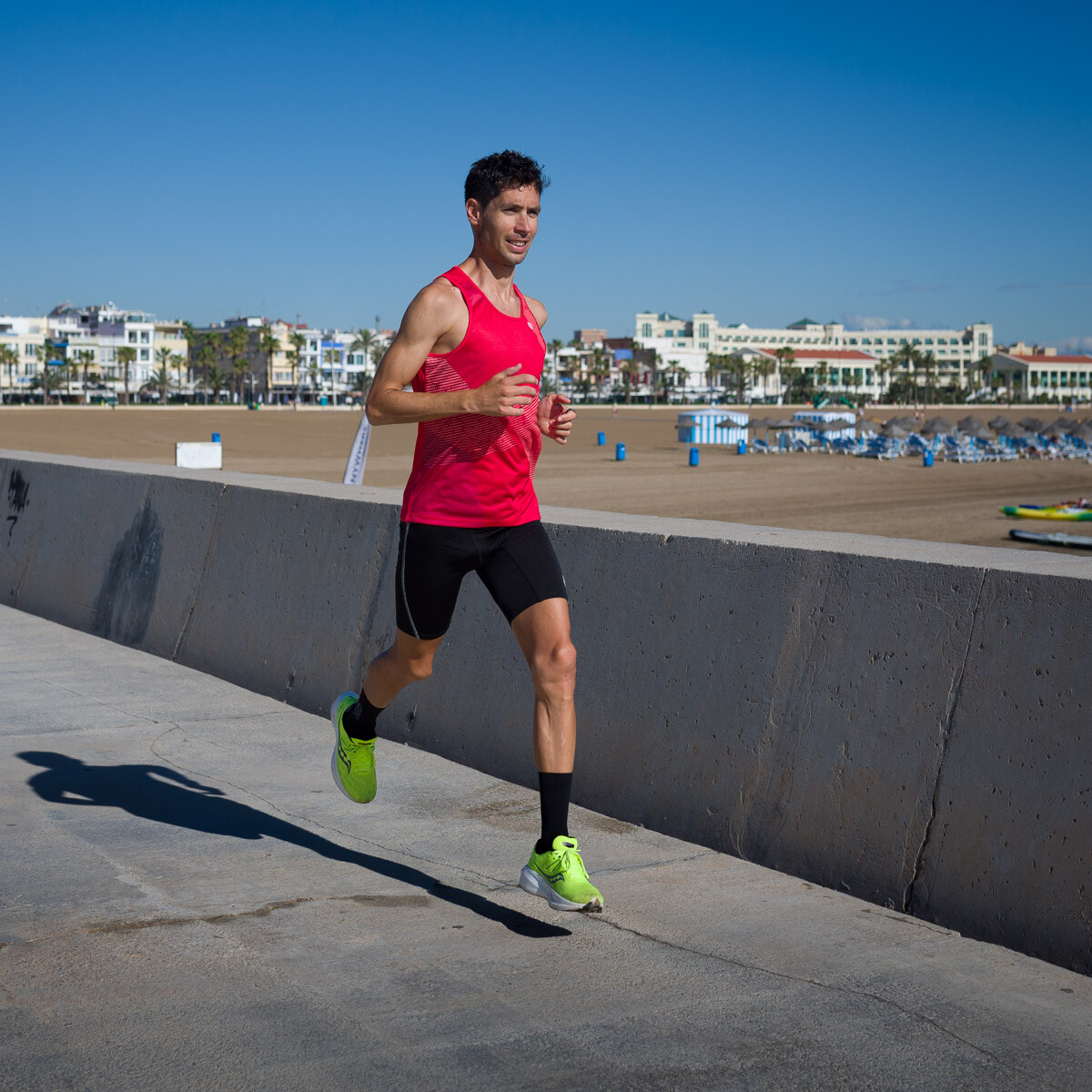
While the highly trained runner uses intramuscular fatty acid oxidation and is much less dependent on muscle glycogen (glucose store), the less trained athlete consumes a greater amount of carbohydrates (glucose) and a lower proportion of fatty acids. This supposes a lower sports performance in the case of the less trained athlete, because glycogen is very limited, while fatty acids can be used for a longer time.
Nutritional recommendations to face a competition
But what, when and how should we eat before a race? We are going to see the what, when and how of what to eat and drink before facing a demanding physical activity.
– About 3 hours before physical activity
3 hours before facing the test, a intake rich in alimefoods rich in carbohydrates (since glucose shortage is directly related to fatigue and decreased sports performance) and to a lesser extentlimented with protein, fiber and fat.
If we have the competition in the morning, my breakfast proposals would be the following:
- Milk or vegetable drink with cereals.
- Milk or vegetable drink with toast with honey.
- Milk or vegetable drink with oats.
If we have the competition in the afternoon, my lunch/meal proposal would be the following:
- pasta or rice (always white) with a small amount of vegetables and a little bit of tuna.
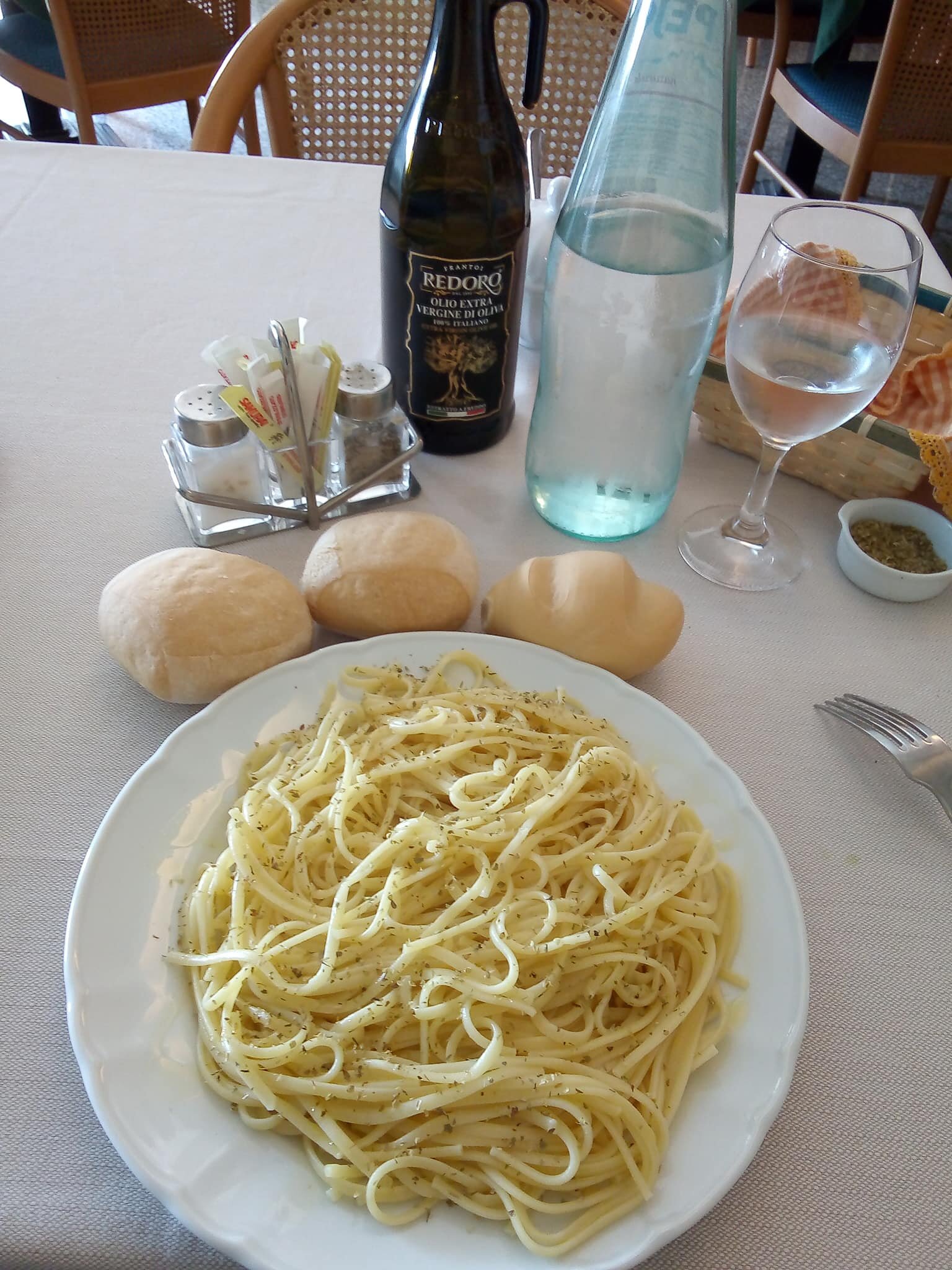
Why pasta or white rice? Well, because its digestion is much faster and therefore the assimilation of its nutrients is also much faster. Furthermore, to ensure correct and rapid assimilation, both pasta and rice must be well cooked and not "al dente" because it will be much more difficult to digest.
– Between 30 and 60 minutes before physical activity
The protocol at this time will start with 2-3 glasses of water about 15-20 minutes before making this intake to avoid slowing down digestion.
between the tolimeIn the absence of approximately 1 hour before the start of the test, it is necessary to include aliments of easy digestion as bread with honey, quince or jam; Skimmed yoghurts, non-whole grain cereals, low-fat biscuits, non-whole muesli, fruit or dried fruit.
All of this can be replaced by a few 300-500ml of isotonic drink rehydration sugar.
– Between 5 and 10 minutes before the start of the test
Ingest isotonic drink sugary orlimeFoods in small quantities that are very easy to digest, such as dried fruits. In case you do not consume isotonic drinks at the moment, take 2-3 glasses of water.
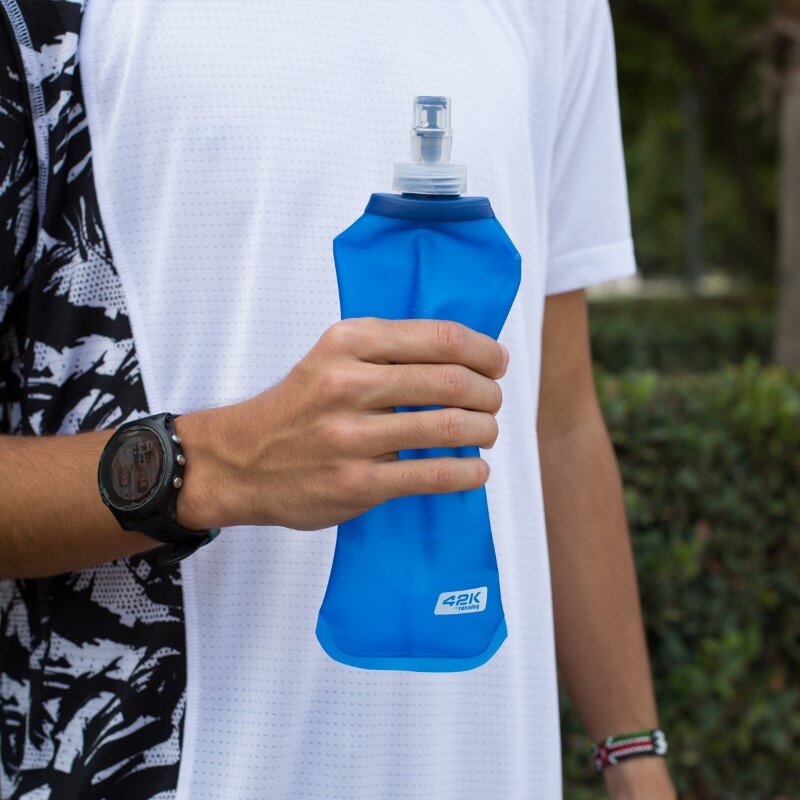
Everything must be trained before the race: also food and drink
A very important warning is that everything you eat or drink before the race must have been tried several times previously on training days. On the day of the competition you do not have to do experiments: no need to trylimeFoods or drinks that we have not tried before and we are sure that they feel good to us.
It is recommended try everything in training first and adapt these guidelines to our protocol. I give an example: the isotonic drink 5 minutes before the start may not feel good, but a handful of raisins and dried apricots do; Or that an hour before you don't feel like a jam sandwich but you do feel like some non-integral cookies. It is very important that each athlete knows himself as well as possible and knows with certainty what tolimeFood and drinks work for you and feel good.
None of the advice or recommendations on what to eat before a race that appear in this article (or in that of any other nutrition specialist) should be put into practice on the day of the race as it is possible for discomfort, allergies, intolerances, hypoglycemia...
I insist again that it is vitally important do not introduce changes or do tests on our a guidelineslimentation the day of competition because we can ruin the preparation of many months for a foolish thing. Not only do you have to train resistance, strength or elasticity, but also you have to train thelimentation and hydration, especially when we face tests that will require a prolonged and constant effort of more than 60 or 90 minutes.
Of course, you don't have to worry as much about what to eat before a 5K race as what to eat before a half marathon or a marathon. My advice to those runners who intend to prepare for a competition such as the half marathon or the marathon is to see a sports nutritionist for advice and guidance on the correctlimentation that they must incorporate into their planning for the sporting objective.
La Plantar fasciitis is one of Most common injuries among popular runners and in some cases, if not given the proper treatment and on time, it can become a terrible nightmare of several months of aches, pains and inability to run.
Although the annoying plantar fasciitis affects 10% of the population, It is more common in profiles such as the popular runner, so we are going to see some tips for runners who want to recover from plantar fasciitis.
To answer the question of whether trigger points o "tigger points" can trigger the Plantar fasciitis, It is essential to define each of these concepts in such a way that the possible causal relationship between them can be understood.
The two sports specialties in which it occurs the most are long-distance runners and basketball players. However, it can occur in people who do not play sports regularly, although in these cases it usually appears after 45 years of age.
What is plantar fasciitis and trigger points?
In the anatomy of the foot, the "plantar fascia" or arcuate ligament It is a band of connective tissue that joins the heel with the toes, that is, a thick ligament that stretches when you take a step. Consequently, if a tear or a contraction is caused in the attached muscles, pain appears (plantar fasciitis).
Normally, it hurts in the heel as injuries occur more frequently in this area, but the pain can appear in the middle and anterior part of the sole of the foot. The causes of this injury are diverse, including excessive physical activity, retraction of the Achilles tendon, arthritis and diabetes, and even wearing defective footwear. But, then, what relationship does it have with trigger points?

Is named trigger point to a very specific area or a group of fibers that contracts within the muscle tissue, forming a type of nodule that causes pain when it is active. People who suffer from them often refer to them as "balls", "contractures" or "knots" because they can notice, when they put pressure on them, a kind of swelling.
A characteristic of these nodules is that can be highly irritable And be source of pain in the area where they are or radiate the pain to other areas of the body. They are produced by excessive muscle contraction, stress or inadequate calcium metabolism.
Well, by linking both concepts you can intuit what happens in this case. One or more trigger points located in the gastrocnemius muscles (external and internal) can project the pain towards the heel, as occurs on many occasions. Trigger points do not follow neurological or visceral patterns, which is why, on occasions, it is difficult to locate them and the amount of pain depends on the degree of irritability of the same.
Plantar fasciitis, a common injury in athletes
Plantar fasciitis occurs due to the tendon fascial tissue overload that holds the foot and that is located on the sole. Athletes who make a continuous effort and highly repetitive movements with their feet, such as athletes or soccer players or basketball players, are usually one of the most affected by this ailment.
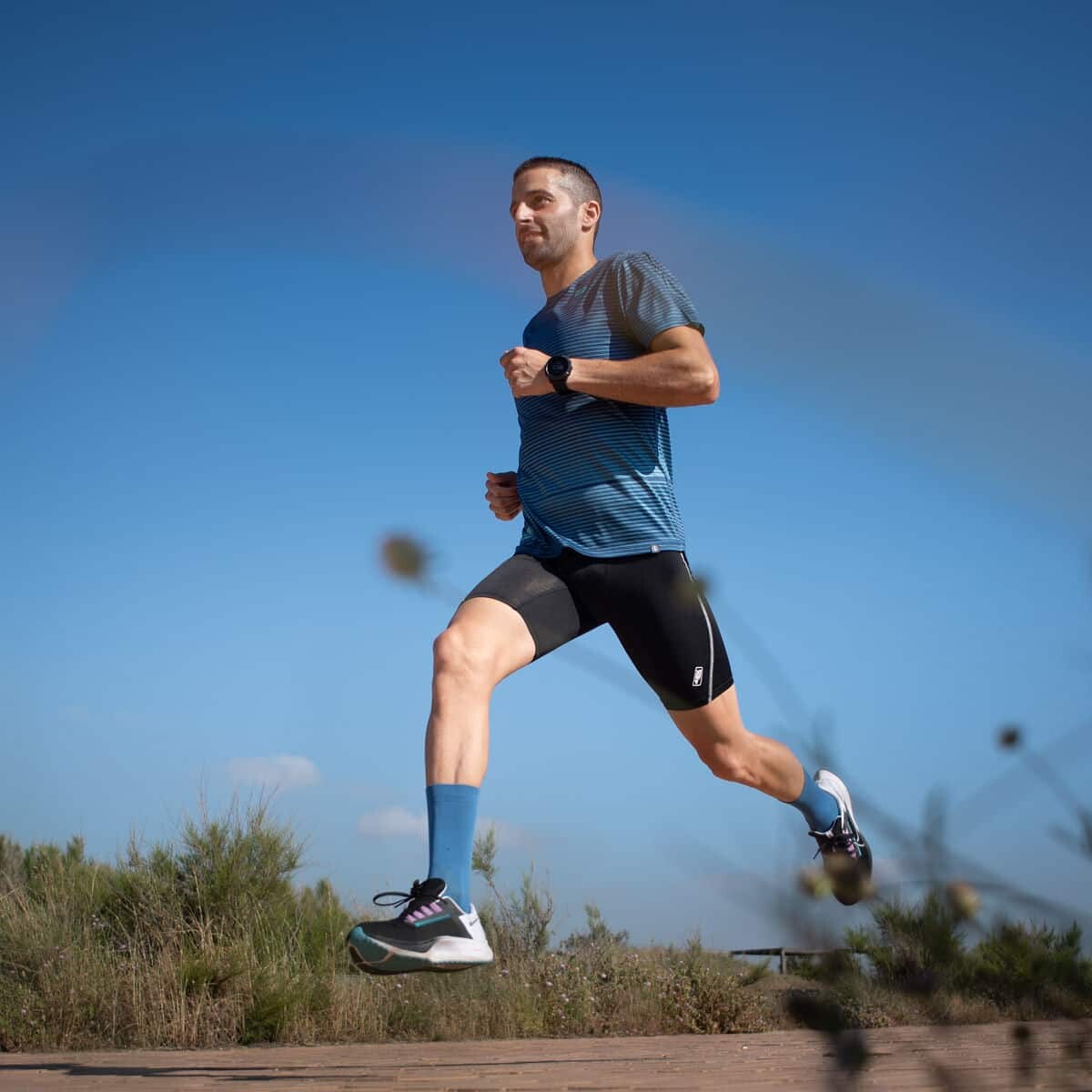
How does plantar fasciitis occur?
The function of the plantar fascia is to provide stability and shock absorption capacity to the longitudinal arch of the foot. The inflammation of the membrane or aponeurosis that covers the muscles of the sole of the foot and its insertional area in the heel, caused by the tractions in each impact and in the propulsion movements of the foot, is what is called in sports medicine, plantar fasciitis.
The high-performance activity to which professional athletes subject their heels, especially when running on hard ground or surfaces, cause continuous percussion on the soles of the feet, which produce micro-traumatisms, which in turn are responsible for a possible inflammation of the heel and its consequent generation of pain.
In some cases, chronic heel pain can also be caused by a so-called calcaneal spur (spike at the bottom of the heel seen on X-ray), which also causes inflammation around the fascial fibers, although it has no cause. why be the cause of plantar fasciitis. Between 15 and 25% of the population have a heel spur but do not experience pain and, in contrast, many runners with plantar fasciitis do not.
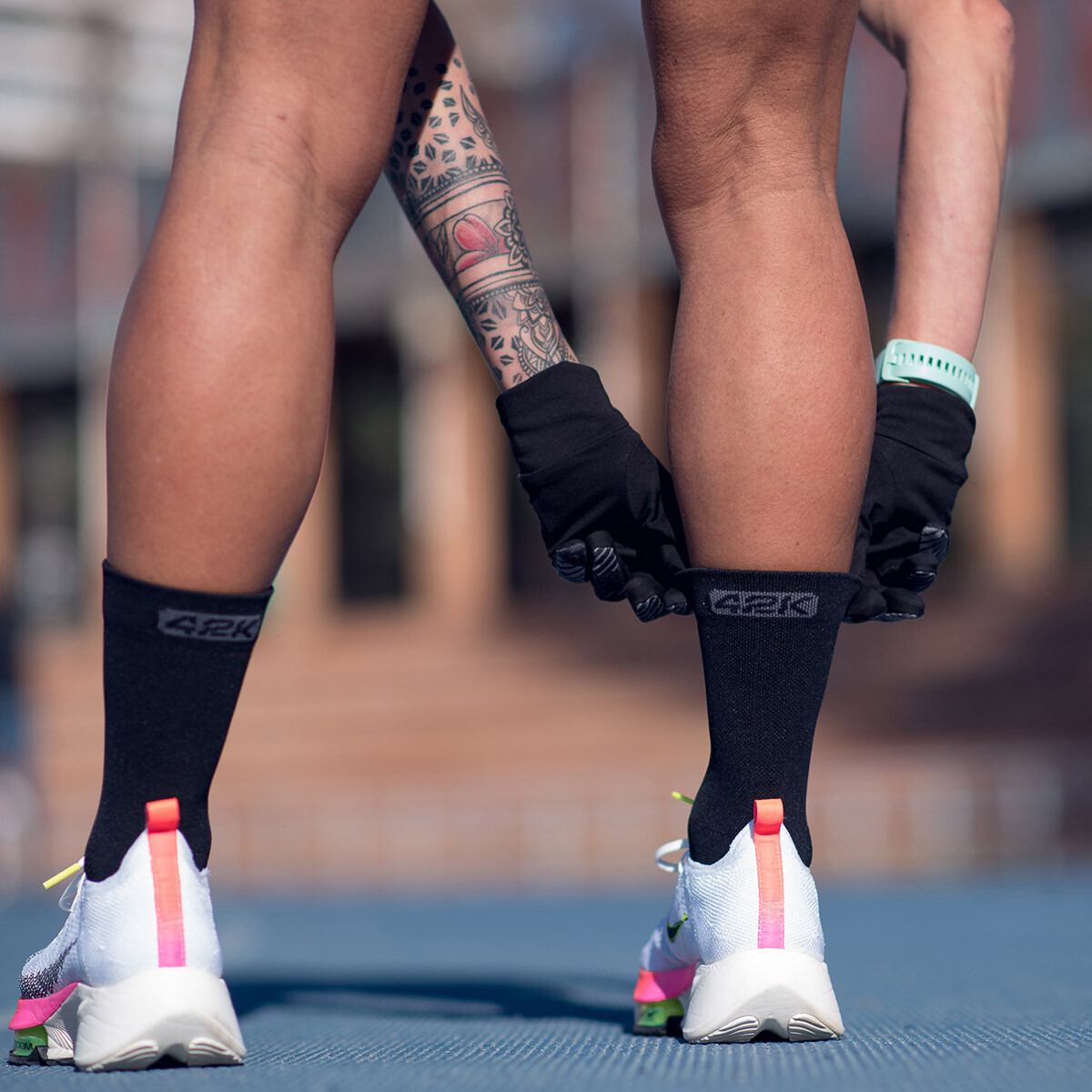
The main causes of this injury are:
- Overload: It is usually the most common and is caused by the excessive use of the joint or the repetition of a sports technique developed in an erroneous way.
- Change of footwear: It is very common for plantar fascia pain to appear when renewing sports shoes.
- Bone problem: Some bone-type malformation can generate plantar fasciitis.
Main symptoms of plantar fasciitis
When you suffer from plantar fasciitis the main symptoms are the following:
- Pain: It is what the patient suffers the most and the first thing he notices when doing any sporting activity.
- Tenderness and swelling
- Heat
- Redness
- Tension in the sole of the foot
Prevention
Prevention of plantar fasciitis is relatively simple: the warming up and el stretching prior to physical exercise is essential to avoid it. Before each training session, a light run of 5 or 10 minutes is recommended. Afterwards, it is necessary to carry out, in addition to the general stretching, some specific ones on the sole of the foot to reduce the probability of injuries to the fascia of the foot and the muscle-tendon structures.
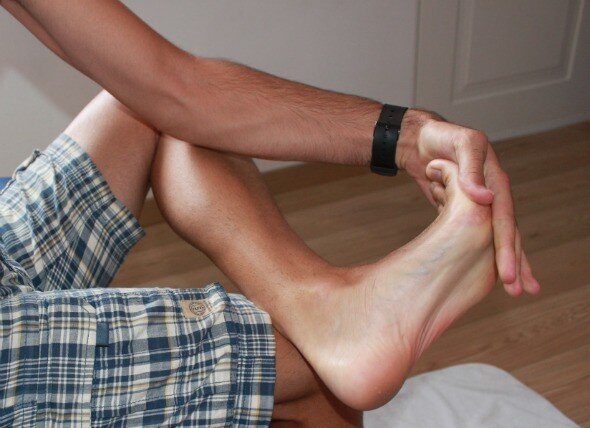
La choosing the right shoe it is essential. The shoe must be comfortable, with an appropriate size for the foot, since the feet may not be symmetrical. The athlete must try each new pair of shoes even if they are the same model that he usually uses.
How to treat plantar fasciitis?
El treatment of tigger points or trigger points It is based on physiotherapy with the performance of pressure massages on these nodes. The most widely used techniques that produce significant improvements are decontracting mesotherapy, cryotherapy, the dry needling technique, stretching prescribed by the physiotherapist and post-isometric relaxation.
In short, when there is pain in the sole of the foot and there has been no injury or any of the usual causes have been ruled out, it is necessary to guide the examination towards the detection of trigger points as a possible cause of the pain. plantar fasciitis
Once the diagnosis has been made, usually through a physical examination and the description of the symptoms reported by the patient, the sports doctor will decide which is the action protocol to be carried out. Only exceptionally is surgery used to treat this type of injury.
Although, there is no evidence of the effectiveness of a specific treatment for plantar fasciitis, there is a series of recommendations that in many cases can lead to its cure. Among them is the correction of training errors.
To heal quickly and without relapses, the injury must be identified as soon as possible and begin to avoid the painful gesture that causes it, since once it is established, it can take 8 to 18 months for the definitive healing.
Plantar Fasciitis Treatments
- In the acute phase of pain, use ice, and will apply Massage of about the zone of 10 or 20 seconds, 3 or 4 times a day. This prevents inflammation. Repeated use of ice or cryotherapy is the most effective treatment as cold limits pain, swelling, bruising and inflammation.
- The ultrasound continuous (5-10 W/cm) for about 5 minutes a day, they will be used in the post-acute phase of the injury, at 48 hours. The effects of ultrasound (pain reduction, increased blood flow, increased metabolism and reduced muscle spasm) help in the treatment of the injury, and give good results in athletes.
- Un deep massage, in small circular movements on the affected region, will reabsorb the edema and reduce muscle spasm.
- Combining ultrasound with electrical stimulation it can also be effective. Ultrasound acts on deep tissues and muscle stimulation increases the flexibility of the sole of the foot.
- The extracorporeal shock waves can help runners and athletes with plantar pain of more than a year of evolution, with chronic pain in the heel area. Some doctors recommend it, but its effectiveness is still under study.
- El tapping (bandage with adhesive tape strips) can help relieve pain. Such a bandage will limit the stress on the plantar fascia. It is also useful in case of a rupture of the aponeurosis.
- When acute pain is experienced, you can use templates shock absorption, discharge insoles, personalized insoles with previous biomechanical studies to correct the varus-valgus of the foot.
Tips for Coping with Plantar Fasciitis
If you suffer from plantar fasciitis, the first thing is to rest. It's never easy, especially if you have to walk a lot because of your work, but the ideal is to reduce the number of days of running, or even eliminate the series for swimming or cycling. It is also advisable to put a bottle of frozen water under the sole of the foot and roll it little by little for 8 or 10 minutes two or three times a day.
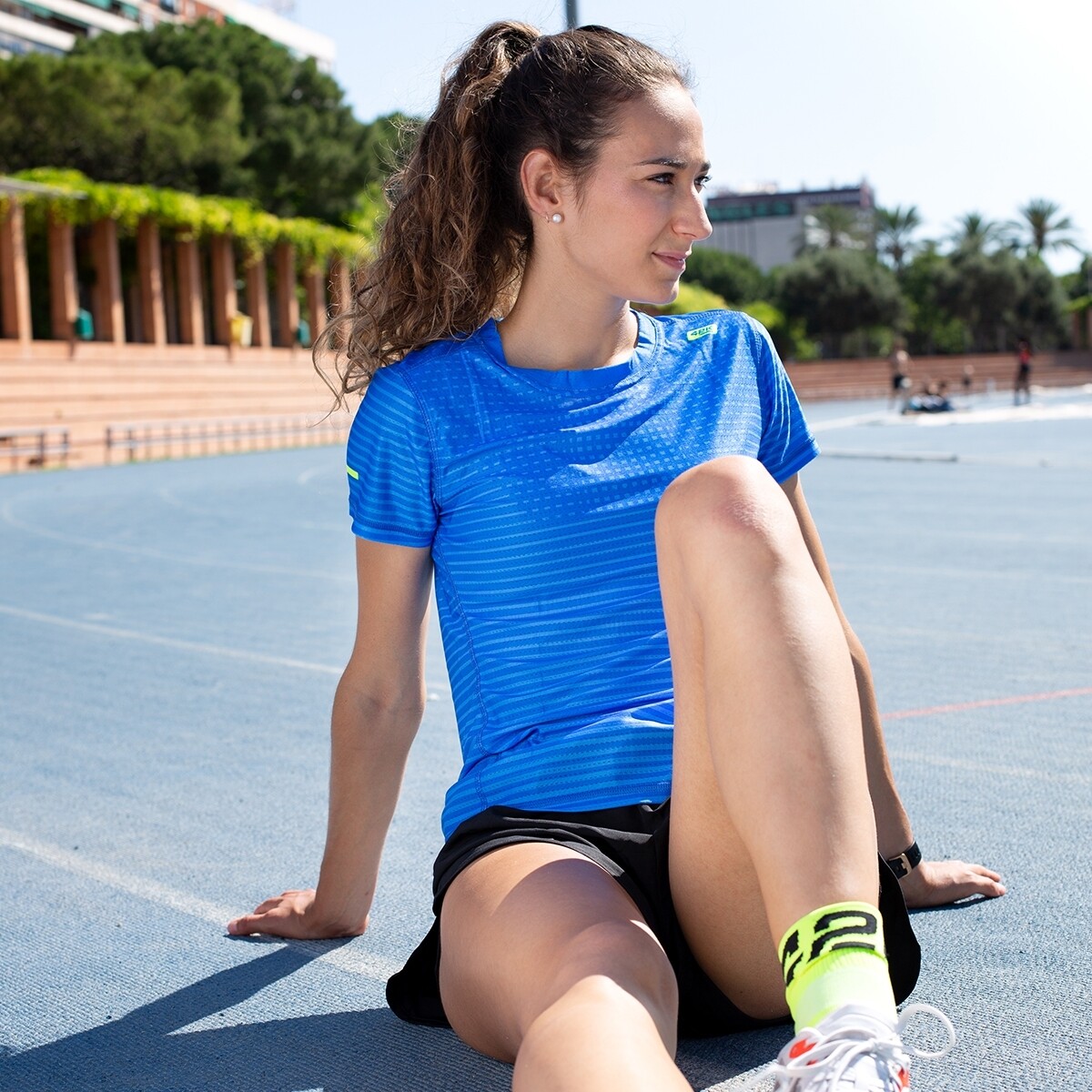
We must also pay attention to footwear (and not only the one we use for sports, but also the one we use in our daily lives), an aspect that we don't always give the importance it deserves and that can be behind sports injuries such as plantar fasciitis. Whether for running or for day-to-day use, wear shoes with good cushioning, which are comfortable and support the arch of the foot.
Be careful with flip flops or flip flops
Be careful with flat or worn shoes and sneakers; likewise, have be careful with the use of flip-flops or flip-flops because it is a type of footwear that can cause many problems if it is not used correctly.
In this article of partners They explain very clearly the risks of misusing flip flops or flip flops.
Don't forget the stretches, both of the foot muscles and the heel. You can actually do exercises to strengthen those muscles, for example picking up marbles with your foot and putting them into a cup or towel from the ground with your foot. Stretching with an elastic band and the calf are also interesting.
Finally, it is advisable to go to the specialist to prescribe painkillers such as ibuprofen or even the use of a splint while we sleep. Physiotherapy work is another treatment that will help you recover from plantar fasciitis; Your physio will give you good guidelines to follow to cure it and prevent future problems.
If medical treatment fails, surgery can be performed. Experts only recommend surgery if pain persists after three months of treatment. The foot is one of the key anatomical structures in the athlete. Any discomfort caused by the effort involved in high competition, which affects this area, affects the mechanics and can cause other injuries to the knees, hips, etc.
Elements is the first collection of shirts of running recycled de 42K. This is the great novelty that is incorporated into the catalog of technical shirts of running 42K for 2020. This new collection of t-shirts running is made with polyester yarn obtained entirely plastic bottle recycling and represents a milestone of great importance in the history of 42K.
In addition to Elements The collections are also new in 2020 Lotus y Zenith.
Thus, 42K celebrates its ten years of life as the reference brand of the popular runner in Spain presenting four new collections in 2020: Elements, Lotus, Zenith y Lhotse, first thermocompressive technical shirt of our brand.
Shirts of running recycled inspired by the earth, the aire, fire and water
The new collection of t-shirts running recycled from 42K has been baptized with the name of Elements for being inspired by the strength of the four elements of nature: Earth, aire, water and fire.
There are four models that make up this new collection and each of them receives the name of one of these elements: Earth (Land), Air (AirAnd), Water (Water and Fire (Fire).
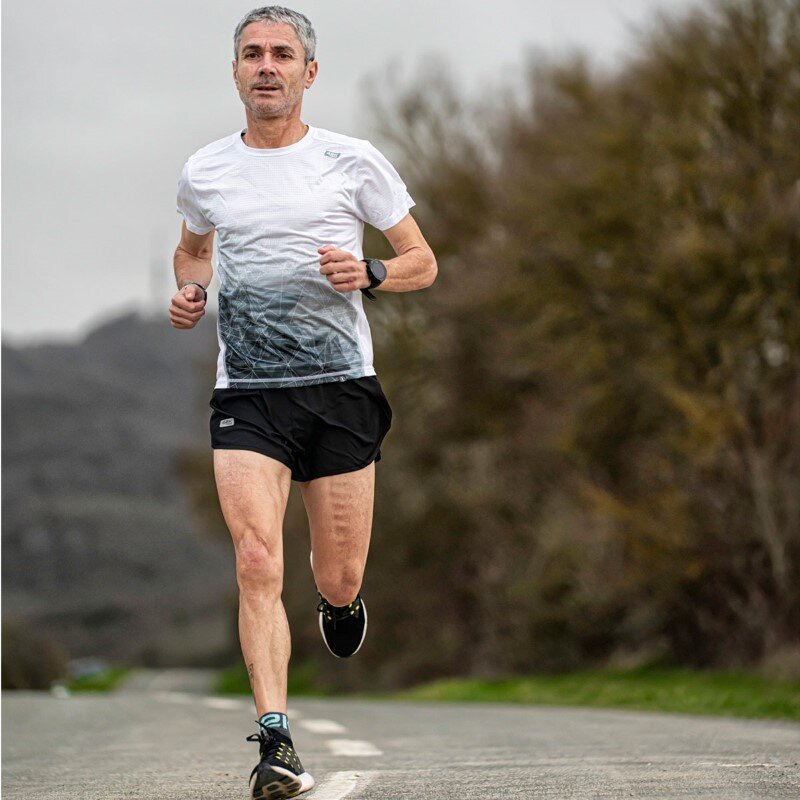
Elements it is the first collection made with Infini_Tech, a technical fabric that is made with polyester thread that comes entirely from the recycling of PET plastic bottles that have been used and discarded.
The birth of this 100% recycled technical fabric has meant making the challenge that we set ourselves in 2018 a reality: giving life in 2020, coinciding with the ten years of life of 42K, to our first collection of t-shirts running recycled.
With the incorporation of Infini_Tech to our catalog of technical fabrics, a new generation of recycled collections, intended for sporting and social events, clubs, groups and individuals, which will have a badge that identifies them as T-shirts. running recycled.
To know the entire collection of t-shirts running recycled Elements, click here.
Martín Fiz and Elena Loyo, ambassadors of the collection Elements
Elements brand a milestone in the history of 42K as it is the first collection of t-shirts running recycled and that is why we wanted the ambassadors of Elements were two great runners: the great world champion Martín Fiz and the olympian Elena Loyo.

The award-winning athlete from Vitoria Martín Fiz has always shown great concern for the care and conservation of the planet, so there could be no better ambassador for Elements.
The also athlete from Vitoria Elena Loyo, double Spanish half marathon champion, has also collaborated with 42K to publicize this collection that has exclusive sizes for men and women. the t-shirts Elements for women they have the same design and color as those for men, but with different measurements to better fit the body of the runners.
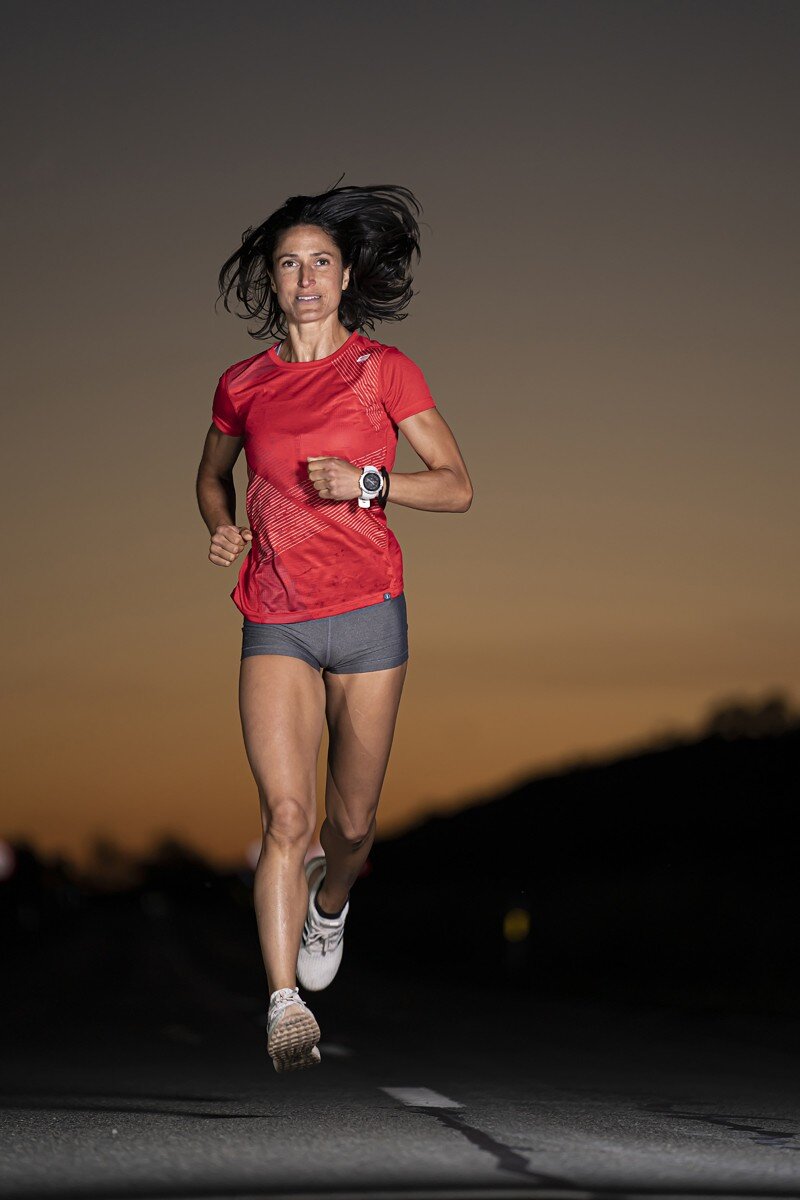
More than 2 million plastic bottles recycled in 2020
The Infini_Tech fabric with which it is made Elements is made with a polyester yarn What do you obtain from recycled material (small balls called 'pellets') into which used plastic bottles are transformed.
More than 2 million PET plastic bottles will be recycled throughout 2020 to generate the polyester thread necessary to bring the collection to life Elements.
each t-shirt Elements It is made with polyester thread resulting from the recycling of approximately 20 500ml plastic bottles. (calculation made with a size L t-shirt).
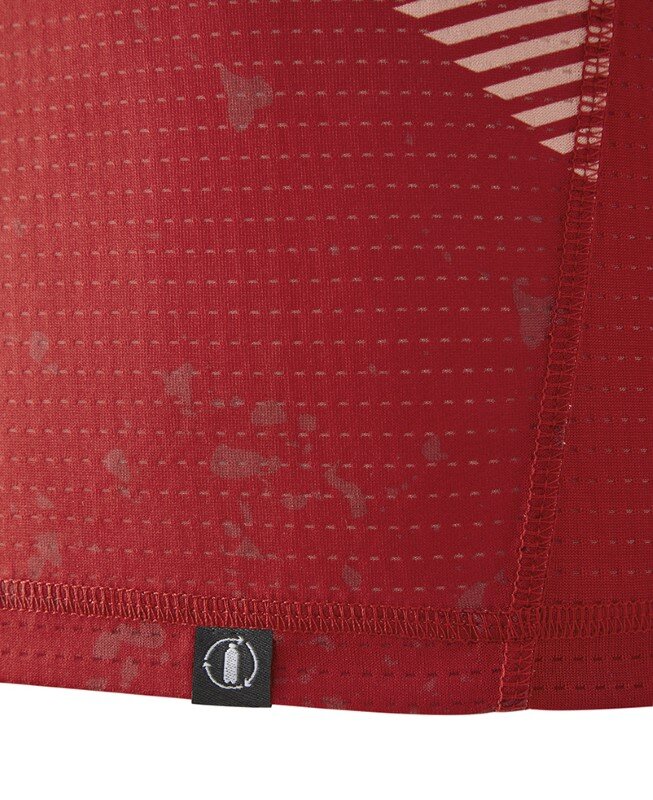
The T-shirts of running recycled Elements, as well as all the garments made with Infini_Tech recycled fabric, have been exhaustively tested in different temperature and humidity conditions.
Infini_Tech fabric offers the same performance as normal polyester fabric, but with one big difference: it has less impact on the planet.
Features of the t-shirts running recycled Elements:
- Shirts of running recycled fabrics made with the new Infini_Tech fabric.
- The Infini_Tech technical fabric is made from 100% recycled polyester.
- Positional sublimated front.
- Sublimation guarantees breathability and does not increase the weight of the garment.
- Flat seams and anti-scratch printed label.
- Maximum breathability and fast drying "DRY-TEC +".
- Anti-scratch treatment "SOFT-LIGHT".
- Excellent "DC4" color fixation.
- Ergonomic front pattern with rear panel Longer back.
- Seated style sleeve.
- Anti-friction seam cover on neck.
- 100% recycled identification label.
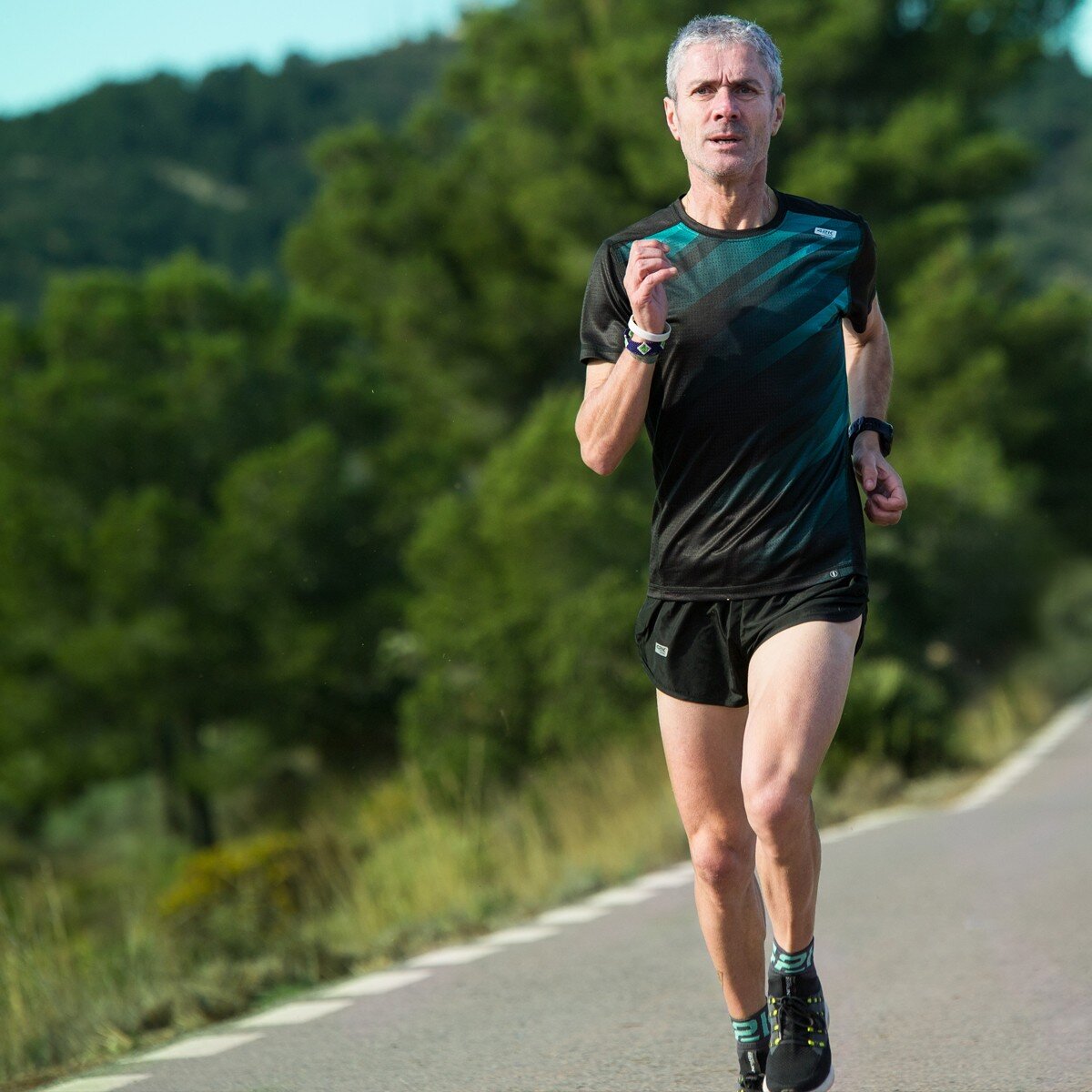
New life for PET plastic bottles: t-shirts running recycled
Recycling is a necessary commitment to respond to global warming, the main problem facing our planet.
Betting on recycling is a necessary commitment to contribute to caring for the environment, but also as an important support for sustainable development, since it allows saving natural resources that are not infinite.
The polyester thread with which Infini_Tech is made involves the elimination of used PET plastic bottles that, if not recycled, could end up as polluting waste in marine ecosystems or aquifers.
Also, when giving a new life to PET plastic bottles a important commitment to sustainability, since the consumption of oil (a non-renewable raw material) is reduced and significant energy savings are achieved since the extraction, transport and processing of oil is not necessary, in such a way that the amount of CO2 that is it is released into the atmosphere and it is one of the main causes of global warming.

Progressive commitment to recycled fabric to continue creating t-shirts running recycled
The great objective of 42K for the coming years is to progressively increase the presence of collections of sportswear and accessories made with recycled fabrics. The commitment to t-shirt collections running recycled will be extended to most new collections in the coming years.
There are many reasons why it is important to bet on recycling, but we consider that the most important are the following:
- Save energy and fight climate change.
- Conserve and care for the environment.
- Reduce the consumption of non-renewable raw materials.
- Manufacture new products by reusing waste materials.
Care for t-shirts running recycled
If you want to know how to wash your sportswear, especially your t-shirts running recycled, to keep them in good condition you must read the article on our blog titled How to wash sports clothes to make them last longer
In this article we explain the care that sportswear requires so that it preserves its technical characteristics of breathability, softness or vivid colors for as long as possible.
There are a series of care and cleaning recommendations for sportswear that, in addition to serving to extend its useful life, will also serve to prevent unpleasant odors from appearing or unpleasant. On this issue you can also find an article on our blog entitled 3 tricks to eliminate the bad smell in sportswear.
As we mentioned previously in our blog, one of the most common injuries among popular runners It is plantar fasciitis, it is one of the worst injuries we can find. Although this discomfort in the feet affects 10% of the population, it is more common in profiles such as the popular runner, so we are going to see some tips for runners who want to recover from plantar fasciitis.
If you suffer from plantar fasciitis, the first thing is rest. It is never easy, especially if you have to walk a lot because of your work, but the ideal is to reduce the number of days of running, or even eliminate the series for swimming or cycling. It is also advisable to put a bottle of frozen water under the sole of the foot and roll it little by little for 8 or 10 minutes two or three times a day.
We must also pay attention to footwear, an aspect that we do not always give the importance it deserves and that can be behind sports injuries such as fasciitis. Whether for running or for everyday use, wear shoes with good cushioning, that are comfortable and support the arch of the foot. Be careful with flat or worn shoes and sneakers.
Don't forget the stretches, both of the foot muscles and the heel. You can actually do exercises to strengthen those muscles, for example picking up marbles with your foot and putting them into a cup or towel from the ground with your foot. Stretching with an elastic band and the calf are also interesting.

Finally, it is advisable to go to the expert to prescribe pain relievers such as ibuprofen or even the use of a splint while we sleep. Physiotherapy work is another treatment that will help you recover from fasciitis, and the physio will give you good guidelines to follow to cure it and prevent problems in the future.
42K · All rights reserved
